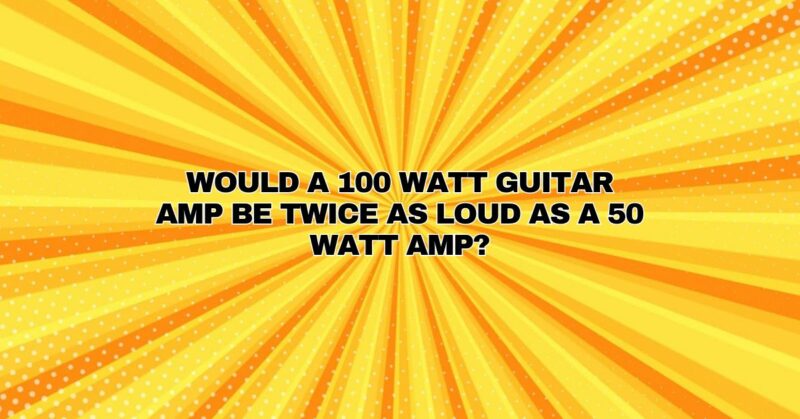When it comes to guitar amplifiers, the relationship between wattage and loudness can be a source of confusion for many musicians. It’s a common misconception that doubling the wattage of an amplifier results in a perceived doubling of volume. In reality, the relationship between wattage and loudness is not linear, and several factors come into play. To understand this better, let’s explore how wattage affects the loudness of a guitar amplifier and why a 100-watt amp may not necessarily be twice as loud as a 50-watt amp.
Understanding Wattage
Wattage in amplifiers refers to the power output of the amplifier, which determines how much electrical energy the amp can convert into sound. In essence, it measures how loud the amp can get. However, it’s crucial to understand that perceived loudness depends on more than just the amplifier’s wattage.
The Decibel Scale
Sound volume is measured in decibels (dB), which is a logarithmic scale. This means that each increase of 10 dB represents a tenfold increase in perceived loudness. For example, if you have one amplifier producing 100 dB of sound, doubling the wattage and using a second identical amplifier will not result in 200 dB of sound; it will only be about 103 dB. Therefore, the relationship between wattage and perceived loudness is not linear but rather logarithmic.
The 3 dB Rule
In practical terms, most people perceive a doubling of power (wattage) as an increase of about 3 dB in volume. This means that if you have a 50-watt amplifier and switch to a 100-watt amplifier, you will likely notice a moderate increase in volume, but it won’t be perceived as twice as loud. The additional 50 watts will primarily provide more headroom, allowing the amplifier to handle the peaks in your playing without distorting.
Other Factors Affecting Perceived Loudness
Several other factors can influence how loud an amplifier appears to be, and these factors are just as important, if not more so, than wattage:
- Speaker Efficiency: The efficiency of the amplifier’s speaker(s) plays a significant role in volume output. More efficient speakers can convert a higher percentage of the amplifier’s power into sound, resulting in a louder and more effective amp.
- Speaker Size and Configuration: The size and configuration of the speaker(s) in the amplifier cabinet can affect the dispersion of sound and how it’s perceived. Larger speakers and multiple speaker setups can move more air, creating a greater sense of volume.
- Cabinet Design: The design and construction of the amplifier cabinet can impact how sound is projected. Closed-back cabinets may focus sound more narrowly, while open-back cabinets can create a more expansive and diffused sound.
- Room Acoustics: The acoustics of the room in which you’re playing have a substantial influence on perceived loudness. The size, shape, and materials in the room can affect sound reflection and absorption.
- Player’s Perception: A player’s perception of loudness can be subjective and influenced by various factors, including the type of music being played, the guitar’s pickups, and the player’s familiarity with the amplifier.
When Wattage Matters
While wattage alone doesn’t linearly dictate loudness, it can still be crucial in specific situations:
- Clean Headroom: Higher-wattage amplifiers typically provide more clean headroom. This means they can stay clean and undistorted at higher volumes, making them suitable for genres or playing styles that require clean tones at loud volumes.
- Larger Venues: In larger venues or outdoor settings, higher-wattage amplifiers may be necessary to project sound effectively to the audience.
- Clean vs. Overdriven Tones: If you want a clean, undistorted tone at high volumes, a higher-wattage amp may be preferable. However, if you’re looking for power amp distortion, a lower-wattage amp may suffice.
Conclusion
In summary, the relationship between amplifier wattage and perceived loudness is not a straightforward linear one. Doubling the wattage from a 50-watt amp to a 100-watt amp will result in a moderate increase in volume, typically around 3 dB louder, but it won’t be perceived as twice as loud. Many other factors, such as speaker efficiency, speaker size, cabinet design, and room acoustics, play significant roles in how loud an amplifier appears to be.
Ultimately, the choice of amplifier wattage should be based on your playing style, the venues you perform in, and your tonal preferences. It’s also essential to consider factors like speaker efficiency and cabinet design, as they can have a more significant impact on perceived loudness than wattage alone. In the world of guitar amplification, it’s not just about the numbers but about finding the right combination of equipment to achieve the tone and volume that suits your musical goals.


